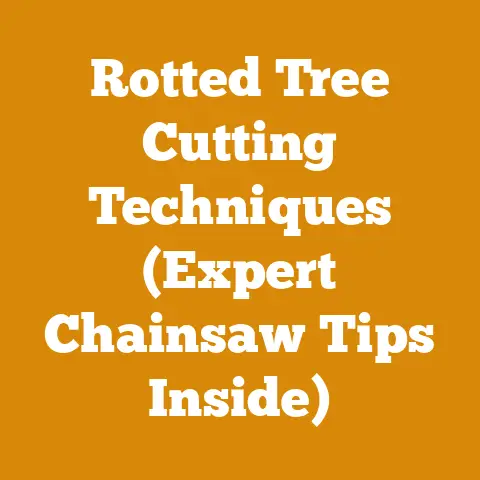Stihl 4 Cycle Weed Trimmer Tips (5 Pro Arborist Secrets)
Introduction: The Frustration of a Finicky Four-Cycle
I remember the first time I picked up a Stihl four-cycle weed trimmer. I’d been using two-cycle trimmers for years, the kind where you mix gas and oil, and thought I knew the drill. “How different could it be?” I scoffed. Famous last words. That initial experience was… humbling. It sputtered, it stalled, and it generally refused to cooperate. I felt like I was wrestling an angry badger.
But I persevered. Over the years, I’ve learned the ins and outs of these machines. I’ve spent countless hours troubleshooting, tinkering, and talking to fellow arborists and mechanics. What I discovered is that while four-cycle trimmers offer significant advantages – cleaner emissions, better fuel efficiency, and often more torque – they also have their quirks. They demand a different level of care and understanding than their two-cycle cousins.
This isn’t just about slapping some gas in the tank and hoping for the best. It’s about understanding the engine’s nuances, the fuel system’s sensitivities, and the specific maintenance routines that will keep your Stihl four-cycle weed trimmer humming for years to come.
1. The Fuel Factor: Octane, Additives, and the Ethanol Enemy
The single biggest mistake I see people make with their four-cycle trimmers is underestimating the importance of fuel quality. Unlike two-cycle engines that are a little more forgiving, four-cycle engines are incredibly sensitive to the type of fuel they ingest.
-
Octane Rating: Always, always use the octane rating recommended in your Stihl owner’s manual. Typically, this is a minimum of 89 octane. Using lower octane fuel can lead to pre-ignition (knocking) and potentially damage the engine over time. It might seem tempting to save a few cents at the pump, but trust me, the cost of repairs will far outweigh the savings.
-
The Ethanol Problem: This is the real enemy. Ethanol-blended fuels, especially E10 (10% ethanol), are notorious for causing problems in small engines. Ethanol absorbs water from the atmosphere, which can lead to phase separation. In phase separation, the ethanol and water separate from the gasoline, forming a corrosive goo that clogs fuel lines, carburetors, and fuel injectors. I’ve seen this firsthand, and it’s not pretty.
- Statistics Speak: According to a 2018 study by the Outdoor Power Equipment Institute (OPEI), ethanol-related fuel problems are the leading cause of small engine failures. They estimated that these failures cost consumers hundreds of millions of dollars annually.
-
The Solution: Ethanol-Free Fuel and Fuel Stabilizers:
- Ethanol-Free Fuel: The best solution is to use ethanol-free fuel whenever possible. You can often find it at marinas or some gas stations that cater to classic car enthusiasts. It might be slightly more expensive, but the peace of mind is worth it.
-
Fuel Stabilizers: If you can’t find ethanol-free fuel, use a high-quality fuel stabilizer specifically designed for small engines. I personally recommend Stihl’s Fuel Protect or STA-BIL Storage Fuel Stabilizer. These stabilizers help prevent ethanol from absorbing water and keep the fuel fresh for longer.
-
My Personal Experience: I once left my Stihl trimmer sitting for about 3 months with regular pump gas. When I went to start it, it refused to fire. After pulling the carburetor, I found it completely gummed up with a sticky residue. Since then, I’ve become a staunch advocate for fuel stabilizers.
-
Pro Tip: Always add fuel stabilizer to your fuel can whenever you fill it up, not just when you’re storing the trimmer for the winter. This will ensure that the fuel is always protected.
2. Oil is Lifeblood: Choosing the Right Lubricant and Maintaining Proper Levels
Just like fuel, oil is crucial for the health and longevity of your Stihl four-cycle weed trimmer. Unlike two-cycle engines where oil is mixed with the fuel, four-cycle engines have a separate oil reservoir, much like a car engine.
-
The Right Oil: Use the oil type and viscosity recommended in your Stihl owner’s manual. Typically, this is a high-quality 10W-30 or 10W-40 oil designed for small engines. Don’t be tempted to use automotive oil unless it specifically meets the specifications outlined in your manual.
- Synthetic vs. Conventional: Synthetic oils offer superior protection against wear and tear, especially in high-temperature conditions. They also tend to resist breakdown better than conventional oils. While they are more expensive, the added protection is often worth the investment.
-
Checking the Oil Level: This is a critical maintenance task that should be performed before each use. Locate the oil dipstick (refer to your owner’s manual if you’re unsure where it is). Wipe the dipstick clean, reinsert it fully, and then remove it again to check the oil level. The oil level should be between the “min” and “max” marks on the dipstick.
- Low Oil Shutdown: Many modern Stihl four-cycle trimmers are equipped with a low oil shutdown feature. This feature automatically shuts off the engine if the oil level drops too low, preventing serious engine damage. However, don’t rely solely on this feature. Regularly checking the oil level is the best way to protect your engine.
-
Changing the Oil: Follow the oil change intervals recommended in your Stihl owner’s manual. Typically, this is every 25 to 50 hours of operation, or at least once a year, even if you haven’t reached the hour limit.
- How to Change the Oil (Simplified):
- Warm up the engine for a few minutes. This will help the oil flow more easily.
- Locate the oil drain plug (refer to your owner’s manual).
- Place a drain pan under the drain plug.
- Remove the drain plug and allow the oil to drain completely.
- Replace the drain plug and tighten it securely.
- Refill the engine with the correct amount of fresh oil.
- Check the oil level with the dipstick and add more oil if necessary.
- How to Change the Oil (Simplified):
-
Oil Leaks: Keep an eye out for oil leaks. If you notice oil puddles under your trimmer or oil residue on the engine, investigate the source of the leak and repair it promptly. Common causes of oil leaks include worn seals, loose drain plugs, and damaged gaskets.
-
Data Point: A study by a leading engine manufacturer found that regular oil changes can extend the life of a small engine by up to 50%. That’s a significant return on a relatively small investment of time and money.
3. Air Filtration: The Silent Killer of Engine Performance
The air filter is the first line of defense against dirt, dust, and debris entering your engine. A clogged or dirty air filter can significantly reduce engine performance, increase fuel consumption, and even cause engine damage.
-
Types of Air Filters: Stihl four-cycle trimmers typically use either foam or paper air filters, or a combination of both. Foam filters are washable and reusable, while paper filters are disposable.
-
Cleaning a Foam Air Filter:
- Remove the air filter from the trimmer.
- Wash the filter with warm soapy water.
- Rinse the filter thoroughly with clean water.
- Squeeze out the excess water.
- Allow the filter to air dry completely.
- Lightly oil the filter with air filter oil. This helps trap dirt and debris.
-
Replacing a Paper Air Filter: Paper air filters cannot be cleaned. When they become dirty or clogged, they must be replaced.
-
Inspection Frequency: Inspect the air filter before each use, especially in dusty conditions. Clean or replace the filter as needed.
-
Environmental Factors: If you live in a particularly dusty or sandy area, you may need to clean or replace the air filter more frequently.
-
Pro Tip: Consider using a pre-filter. A pre-filter is a foam sleeve that fits over the air filter and helps to trap larger particles of dirt and debris. This can significantly extend the life of your air filter.
-
Case Study: I once worked on a Stihl trimmer that had been used extensively in a construction site. The air filter was completely clogged with concrete dust. The engine was barely running and was producing excessive amounts of black smoke. After replacing the air filter, the engine ran like new. This illustrates the importance of maintaining a clean air filter.
4. Spark Plug Savvy: Gap, Condition, and the Art of the Spark
The spark plug is responsible for igniting the air-fuel mixture in the engine. A faulty or worn spark plug can cause hard starting, poor engine performance, and increased fuel consumption.
-
Spark Plug Type: Use the spark plug type recommended in your Stihl owner’s manual. Using the wrong type of spark plug can damage the engine.
-
Spark Plug Gap: The spark plug gap is the distance between the center electrode and the ground electrode. This gap must be properly set for the spark plug to function correctly. The correct spark plug gap is specified in your Stihl owner’s manual. You can use a spark plug gapping tool to adjust the gap.
-
Inspecting the Spark Plug: Inspect the spark plug regularly for signs of wear or damage. Look for:
- Fouling: Fouling is the accumulation of deposits on the spark plug electrodes. These deposits can prevent the spark plug from firing correctly.
- Cracking: Cracks in the spark plug insulator can cause misfires.
- Erosion: Erosion of the spark plug electrodes can widen the spark plug gap and reduce the spark plug’s effectiveness.
-
Reading the Spark Plug: The appearance of the spark plug can provide valuable clues about the health of the engine.
- Normal: A normal spark plug will have a light tan or gray color.
- Black and Sooty: A black and sooty spark plug indicates a rich air-fuel mixture. This could be caused by a clogged air filter, a faulty carburetor, or excessive idling.
- White or Light Gray: A white or light gray spark plug indicates a lean air-fuel mixture. This could be caused by an air leak in the intake system or a clogged fuel filter.
- Oily: An oily spark plug indicates that oil is entering the combustion chamber. This could be caused by worn piston rings or valve seals.
-
Replacing the Spark Plug: Replace the spark plug according to the intervals recommended in your Stihl owner’s manual, or whenever you notice signs of wear or damage.
-
Pro Tip: When installing a new spark plug, tighten it to the torque specification recommended in your Stihl owner’s manual. Over-tightening can damage the spark plug threads, while under-tightening can cause the spark plug to loosen.
5. Carburetor Care: Tuning for Peak Performance and Preventing Clogs
The carburetor is responsible for mixing air and fuel in the correct proportions to create a combustible mixture. A properly tuned carburetor is essential for optimal engine performance and fuel efficiency.
-
Carburetor Adjustments: Most Stihl four-cycle trimmers have three carburetor adjustment screws:
- Idle Speed Screw: This screw adjusts the engine’s idle speed.
- High-Speed Screw (H): This screw adjusts the air-fuel mixture at high engine speeds.
- Low-Speed Screw (L): This screw adjusts the air-fuel mixture at low engine speeds.
-
Tuning the Carburetor: Carburetor tuning is a complex process that requires specialized tools and knowledge. If you’re not comfortable tuning the carburetor yourself, it’s best to take the trimmer to a qualified service technician. However, here are some basic guidelines:
- Start the engine and allow it to warm up completely.
- Adjust the idle speed screw until the engine idles smoothly without stalling.
- Adjust the high-speed screw until the engine runs smoothly at full throttle.
- Adjust the low-speed screw until the engine accelerates smoothly from idle to full throttle.
-
Carburetor Cleaning: Over time, the carburetor can become clogged with dirt, varnish, and other deposits. This can cause hard starting, poor engine performance, and stalling.
- How to Clean a Carburetor (Simplified):
- Remove the carburetor from the trimmer.
- Disassemble the carburetor.
- Clean all of the carburetor parts with carburetor cleaner.
- Reassemble the carburetor.
- Reinstall the carburetor on the trimmer.
- How to Clean a Carburetor (Simplified):
-
Prevention is Key: The best way to prevent carburetor problems is to use high-quality fuel and fuel stabilizer, and to store the trimmer properly when it’s not in use.
-
Real-World Example: A friend of mine had a Stihl trimmer that was constantly stalling and running poorly. He tried everything he could think of to fix it, but nothing seemed to work. Finally, he took the trimmer to a local repair shop. The technician found that the carburetor was completely clogged with varnish. After cleaning the carburetor, the trimmer ran perfectly. This highlights the importance of carburetor maintenance.
Beyond the Basics: Additional Tips for Stihl Four-Cycle Success
While the five secrets above are critical, here are a few additional tips to keep your Stihl four-cycle weed trimmer running smoothly:
-
Proper Storage: When storing the trimmer for an extended period, drain the fuel tank and run the engine until it stalls. This will prevent fuel from gumming up the carburetor. You should also remove the spark plug and pour a small amount of oil into the cylinder. Then, pull the starter rope a few times to distribute the oil. This will help protect the cylinder from rust.
-
Regular Maintenance: Follow the maintenance schedule recommended in your Stihl owner’s manual. This includes tasks such as checking the air filter, spark plug, and oil level, as well as lubricating moving parts.
-
Sharp Cutting Line: Use high-quality cutting line and replace it regularly. Dull cutting line can put unnecessary strain on the engine.
-
Read the Manual: I know it sounds obvious, but read your Stihl owner’s manual. It contains valuable information about the trimmer’s operation and maintenance.
-
Listen to Your Machine: Pay attention to how your trimmer sounds and feels. If you notice any unusual noises or vibrations, investigate the cause and address it promptly.
Understanding Wood Science: A Brief Detour for Arborists
While this article focuses on trimmer maintenance, understanding basic wood science can improve your overall approach to arboriculture and land management. For example, knowing the moisture content of wood affects its weight and burning properties.
-
Moisture Content: Freshly cut wood can have a moisture content of over 100% (based on dry weight). Seasoning wood reduces this moisture content to around 20%, making it lighter and easier to burn.
-
Hardwood vs. Softwood: Hardwoods generally have a higher density and BTU (British Thermal Unit) rating than softwoods, meaning they produce more heat when burned. However, softwoods ignite more easily.
-
Wood Identification: Learning to identify different types of wood can help you select the best wood for specific purposes, such as firewood, construction, or woodworking.
Conclusion: Mastering the Four-Cycle and Maximizing Performance
Owning a Stihl four-cycle weed trimmer doesn’t have to be a frustrating experience. By understanding the nuances of these engines and following the tips outlined in this article, you can keep your trimmer running smoothly and efficiently for years to come. Remember, fuel quality, proper lubrication, air filtration, spark plug maintenance, and carburetor care are the keys to success.
Don’t be afraid to experiment and learn from your experiences. Each machine is slightly different, and what works for one person may not work for another. The most important thing is to be proactive and pay attention to the needs of your trimmer.
So, the next time you pick up your Stihl four-cycle weed trimmer, remember these pro arborist secrets. You’ll be amazed at the difference they can make. Now, get out there and tame those weeds!






